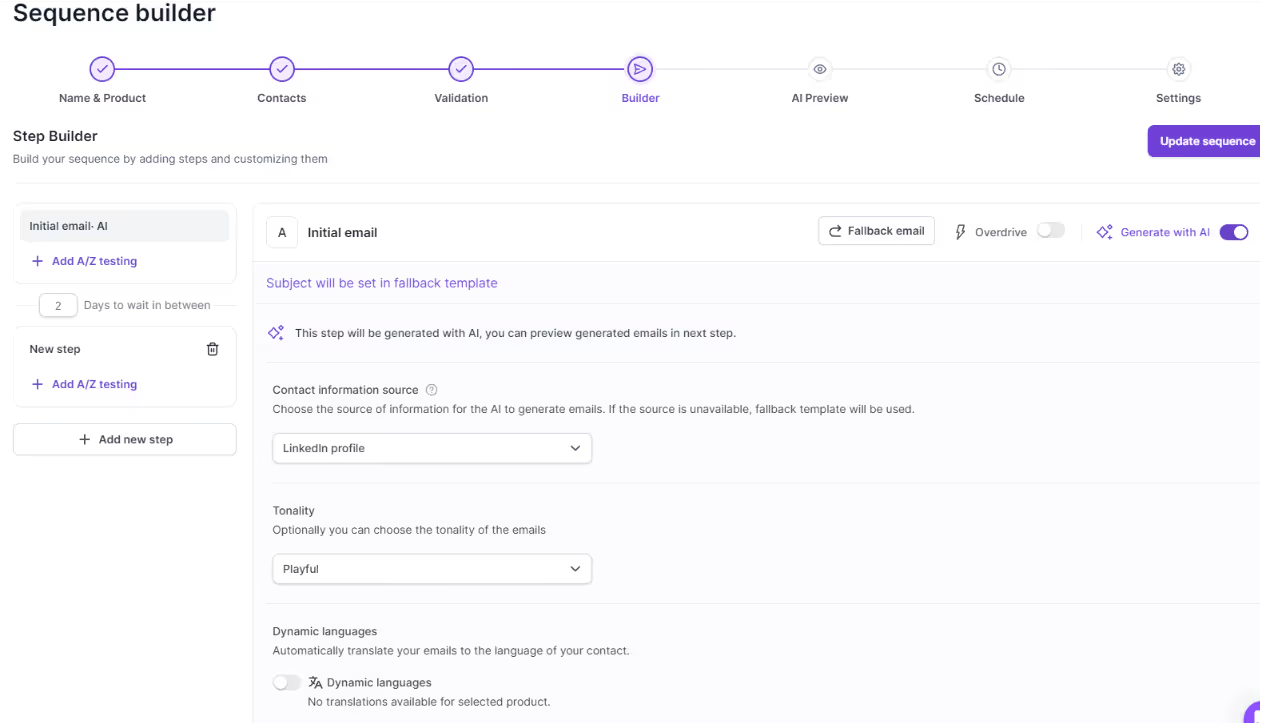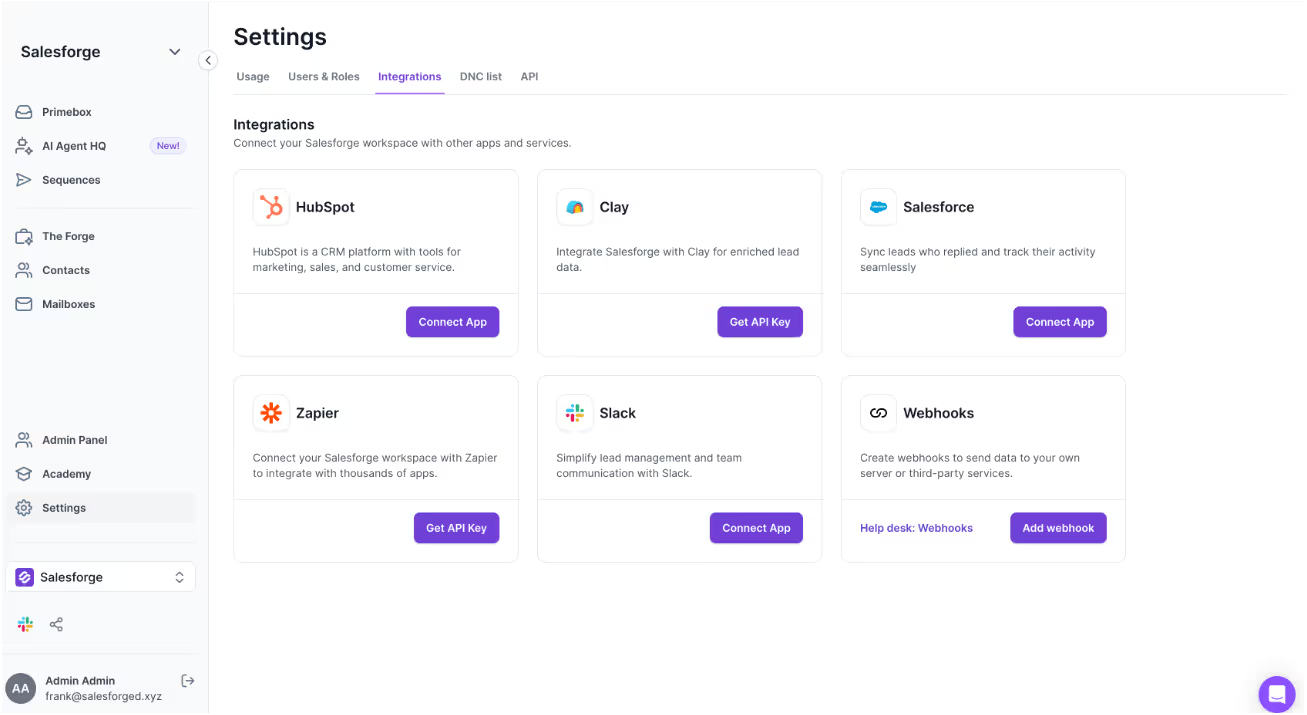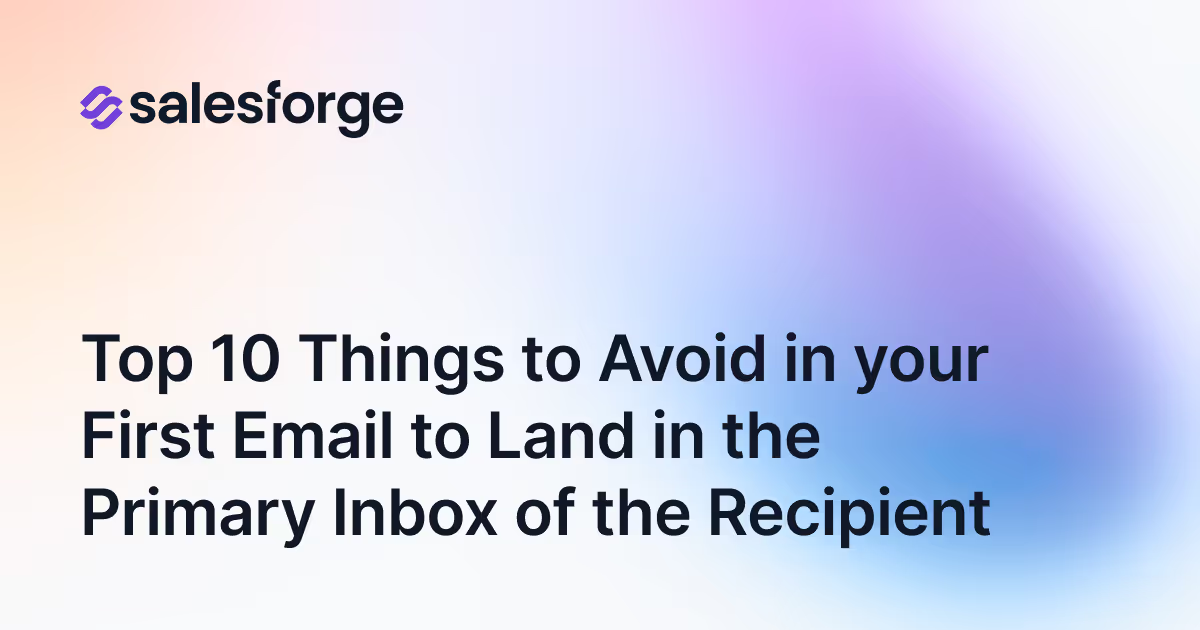Salesforce Email Deliverability Demystified: Is It Good or Bad for Outreach?
If your emails don’t hit the inbox, you’ve already lost. The offer doesn’t matter. The copy doesn’t matter. The follow-ups don’t matter.
That’s why sales teams keep asking: “Is Salesforce email deliverability good enough for outreach?”
On paper, Salesforce is the king of CRMs.
But when it comes to cold email, things aren’t that simple.
The default settings, server controls, and deliverability limits can make or break your outreach campaigns.
This article breaks it down:
- What Salesforce email deliverability actually means.
- Where it works, and where it falls short for outbound.
- The common mistakes that get your emails flagged as spam.
- What you really need if you want inbox placement at scale.
By the end, you’ll know whether Salesforce is helping your emails land, or quietly killing your outreach before it even starts.
What Is Email Deliverability?
Email deliverability is the ability of your email to actually land in the recipient’s primary inbox instead of spam, promotions, or getting blocked outright.
If you care about outbound sales, this is the number that matters more than open rates or send volume.
The Key Metrics That Define Deliverability
- Inbox Placement Rate → The percentage of emails that make it to the inbox. If you’re not measuring this, you’re flying blind.
- Bounce Rate → Emails rejected by the server. High bounce = damaged reputation.
- Spam Complaint Rate → The “this is spam” clicks from recipients. Even a small percentage can kill your sender score.
- Sender Reputation → Think of it as your credit score with Gmail, Outlook, and other ISPs. \
Bad reputation = zero deliverability.
Why Email Deliverability Matters for Sales Teams, Agencies, and Founders?
If you’re a sales team, agency, or founder running outbound, cold email deliverability is the gatekeeper.
No deliverability = no pipeline.
You can have the best copy, perfect targeting, and a killer offer, but if your emails don’t land, it’s wasted effort.
That’s why email deliverability best practices (warm-up, domain setup, list validation) aren’t optional.
They’re the difference between filling your pipeline and burning your domain.
So, deliverability isn’t about how many emails you send.
It’s about how many reach the inbox where business actually happens.
Salesforce Email Deliverability Explained

When people talk about Salesforce email deliverability, most assume it works the same way as a dedicated outreach platform.
It doesn’t.
Salesforce was built for CRM and system communication, not for cold outreach at scale.
The Three Salesforce Deliverability Settings
Salesforce keeps it simple, but these settings decide how your emails behave:
- No Access → Only password reset emails go through. Everything else is blocked.
- System Email Only → Limits emails to system-generated alerts like new user notifications and password resets. This is the default in most Salesforce sandboxes.
- All Email → The only setting that actually allows outbound messages to leave Salesforce. New production orgs usually start here.
These Salesforce deliverability settings aren’t flexible. You can’t fine-tune IPs, domains, or warming sequences.
You either send system emails or you send everything, no middle ground.
Sandbox Defaults and Testing Limitations
By default, Salesforce sandboxes run on System Email Only.
That means most of your test emails never actually hit a real inbox.
For teams trying to test outreach campaigns, this creates a false sense of security.
You think Salesforce is delivering, but in reality, nothing’s getting through.
Why Salesforce Isn’t Built for Cold Outreach
Salesforce’s priorities are clear:
- Transactional emails → password resets, workflow alerts, CRM notifications.
- Internal communications → safe, compliance-first messages.
But cold outreach? Not the focus. There are Salesforce email limits in place specifically to prevent bulk sending.
Their infrastructure is optimized for CRM reliability, not inbox placement at scale.
That’s why many teams hit a wall: Salesforce can manage your customer data, but when it comes to cold email deliverability, you’re playing outside its design.
Is Salesforce Email Deliverability Good or Bad for Outreach?
Let’s cut straight to it: Salesforce email deliverability is good for what it was built for, but bad for outreach.
Where Salesforce Works
Salesforce nails the basics. If you’re sending:
- System notifications (password resets, workflow triggers, approvals)
- CRM alerts (task reminders, updates to team members)
…it’s rock solid. Those emails usually make it through because they’re low-volume, transactional, and align with Salesforce’s core infrastructure.
Where Salesforce Falls Apart
Here’s the catch: Salesforce cold email doesn’t work.
The platform isn’t designed for high-volume sequences, outreach campaigns, or anything that looks like sales prospecting. Why?
- Shared infrastructure → your emails ride on Salesforce servers, not your own.
- Hard email limits → daily sending caps stop you from scaling.
- No warm-up or monitoring → you can’t protect domain reputation or track inbox placement.
This is why most outbound teams run into the same roadblock:
Salesforce feels too restrictive for growth.
You try to push volume, and either your deliverability tanks or you get blocked by Salesforce outbound limitations.
Salesforce is powerful in its own lane (CRM), but the wrong tool for cold email.
If outreach is your growth channel, Salesforce is more of a bottleneck than a solution.
Salesforce or Hubspot: Which CRM is Right for Your Sales Team?
Common Challenges Salesforce Users Face With Deliverability
Salesforce may be the biggest CRM in the world, but when it comes to sending emails, many users hit the same walls again and again.
The reviews say it all.
1. Too Slow and Hard to Use

Many users call Salesforce clunky, slow, and confusing.
Every extra click or lag slows down sales teams.
And when your system is slow, it hurts outreach because you can’t move fast with campaigns.
2. Overcomplicated Setup

Salesforce offers lots of options, but most users complain that it’s too complex to configure.
To change basic deliverability settings, you often need admin or IT support.
For small businesses, that’s a problem.
3. Email Limits Get in the Way
Salesforce has strict email limits to stop users from spamming.
That sounds good in theory, but for outbound teams, it’s a dealbreaker.
You can’t run large campaigns, and you can’t warm up mailboxes to protect your reputation.
4. Not Built for Cold Outreach
Most reviewers agree: Salesforce is made for managing customer records, not for cold email.
It works fine for system emails like password resets or internal alerts, but when teams try outbound campaigns, they find the system restrictive.
5. Poor Testing in Sandboxes
With sandboxes, the default setting is System Email Only.
That means most test emails never actually reach inboxes.
Teams think their emails are working, but in reality, deliverability isn’t being tested at all.
The biggest challenge is simple: Salesforce outbound limitations stop you from using it as a serious outreach tool.
It may handle CRM updates well, but when your business depends on inbox placement, Salesforce falls short.
What Outreach Teams Actually Need for High Deliverability
Getting emails into the inbox isn’t luck. It comes down to having the right setup in place.
Here’s what every outreach team needs if they want consistent deliverability:
1. Dedicated Infrastructure
Shared servers hurt your sender reputation.
Outreach teams need private domains and IPs to control their own reputation, plus proper SPF, DKIM, and DMARC setup.
2. Warm-Up Systems
You can’t go from zero to hundreds of emails a day without raising red flags.
Mailbox warm-up is essential for Gmail and Outlook accounts so providers trust your sending activity.
3. Real-Time Monitoring
Without visibility, you don’t know if emails are going to the inbox, promotions, or spam.
Teams need live monitoring tools, things like inbox placement rates and reputation scores, to catch problems early.
4. Personalization at Scale
Templates don’t cut it anymore. Outreach only works when messages look unique and personal.
That means being able to run personalized campaigns in multiple languages without overwhelming the team.

Salesforce covers the CRM side, but not these deliverability needs.
That’s where Salesforge can help.
With warm-up, infrastructure management, inbox monitoring, and personalization built in, it helps teams fill the gap.
And since Salesforge integrates directly with Salesforce, you don’t have to choose between the two; you can sync leads, map fields, and keep statuses updated while running outreach from the right infrastructure.

Salesforce is great for managing customers, but outreach teams need more dedicated infrastructure, warm-up, monitoring, and personalization.
Salesforge simply makes those pieces easier to manage alongside Salesforce.

The Deliverability Gap in Salesforce (And How to Fix It)
When you look at what outreach teams need, private infrastructure, mailbox warm-up, inbox monitoring, and scalable personalization, it’s clear Salesforce alone doesn’t cover those bases.
That gap is exactly where Salesforge enters.
Unlike CRMs that just send emails, Salesforge is built around email deliverability best practices:
- It provides dedicated infrastructure (through private and distributed domains) so your sender reputation isn’t tied to shared servers.
- It runs an automatic warm-up for Gmail and Outlook mailboxes, which is now a non-negotiable step if you want to avoid spam folders.
- It offers real-time inbox placement checks like Heat Score™, giving you visibility into whether your campaigns are hitting inboxes or getting flagged.
- It supports personalization at scale, including multilingual outreach, which is increasingly important for global teams.
And since Salesforge integrates with Salesforce, it doesn’t replace your CRM; it complements it.
You can import leads, sync statuses, and manage contacts in Salesforce while running the outreach infrastructure that Salesforce doesn’t provide.
For modern outbound teams, Salesforge isn’t “nice to have.”
It’s part of the basic toolkit for cold email deliverability, the difference between building pipelines and burning domains.
Conclusion
Here’s the bottom line:
- Salesforce email deliverability works for what it was built for, system alerts, password resets, and CRM updates.
- It fails for cold outreach. Rigid settings, sandbox limits, shared servers, and no warm-up make it risky for outbound teams.
- User reviews confirm the pain. Too slow, too complex, and too limited for sending at scale.
- Outreach today needs more. Private infrastructure, mailbox warm-up, inbox placement tracking, and personalization at scale aren’t “nice-to-haves”; they’re survival tools.
That’s why relying only on Salesforce for outreach is a dead end. If pipeline growth depends on inbox placement, you need infrastructure built for deliverability.
👉 Salesforge fits in perfectly here.
It integrates with Salesforce, fills the deliverability gap, and gives you the warm-up, monitoring, and personalization Salesforce doesn’t.
If you’re serious about cold email in 2025, keep Salesforce as your CRM.
But for outreach deliverability, you need Salesforge to make sure your emails land where business happens, the inbox.

.avif)


